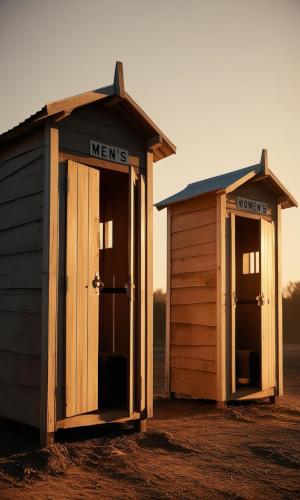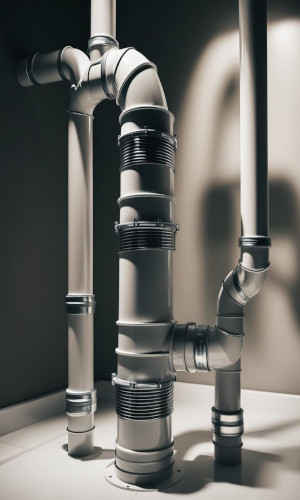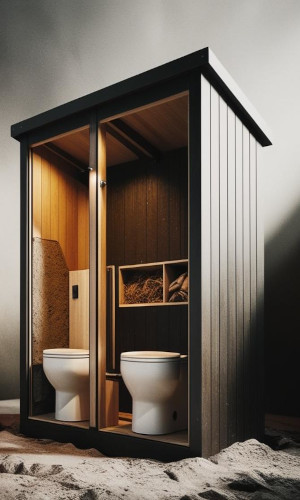A Sustainable Dry Option
Composting toilets emerge as a particularly attractive option for off-grid living due to their “dry” nature and sustainability. Unlike traditional flush toilets that rely on large volumes of water, composting toilets minimize or eliminate water use, making them ideal for environments where water conservation is crucial. These systems operate on the principle of separating liquids and solids, using a urine diverter. This separation is key to the composting process.
The solids are collected in a container where they are mixed with carbon-rich materials like peat moss, coco coir, sawdust, or ash. These materials provide the necessary carbon for microbial decomposition and help maintain optimal moisture levels. The mixture creates an environment where microorganisms can break down the solid waste, transforming it into a stable, humus-like substance. A significant advantage of well-maintained composting toilets is their lack of unpleasant odors. This is because the aerobic decomposition process, when properly managed, does not produce the same odorous compounds as anaerobic systems.

Types of Composting Toilets

Self-contained units:
These are compact and ideal for mobile homes or smaller off-grid structures. They typically include all the necessary components within a single unit, making installation relatively straightforward.
Composting outhouses:
These are larger structures, often built as standalone buildings, suitable for handling waste from multiple users or for permanent off-grid dwellings. They may require more construction effort but can accommodate larger volumes of waste.
Key Components of a Composting Toilet System:
Urine diverter:
This component is crucial for separating liquids from solids. By keeping urine out of the solids container, it reduces moisture levels and promotes a more efficient decomposition process.
Solids container:
This is where the solid waste is collected and mixed with carbonaceous materials. The size of the container will depend on the number of users and the frequency of emptying.
Ventilation system:
A ventilation system, often with a small fan, is essential to ensure the proper airflow required for aerobic decomposition. Ventilation also helps remove any excess moisture and gases.


Carbonaceous material:
The selection of materials such as peat moss, coco coir, sawdust, or ash is essential for proper decomposition. These materials provide carbon, absorb excess moisture, and help manage the consistency of the mixture. Successful operation of a composting toilet requires consistent maintenance.
This includes:
Regular addition of carbonaceous material: After each use, it’s important to add a scoop of peat moss, coco coir, sawdust or ash to the solids container. This ensures the right carbon-to-nitrogen ratio and maintains optimal moisture levels for decomposition.
Occasional stirring:
Lightly stirring the contents of the solids container helps ensure that all materials are properly mixed and helps the decomposition process.
Regular emptying:
Depending on the frequency of use and the size of the system, the solids container must be emptied regularly. The composted material can be further composted or used as a soil amendment for non-edible plants.

Advantages of Composting Toilets

Water conservation :
Composting toilets significantly reduce or eliminate water use, making them suitable for areas with limited water resources or off-grid setups where water is not easily available
Sustainability:
These systems help reduce reliance on conventional sewer systems and decrease the ecological footprint of waste management. The compost can be used to enrich soil.
Reduced infrastructure:
Composting toilets do not require the installation of extensive plumbing or sewer lines. This reduces initial costs and is easier to install in remote areas.
Low maintenance:
When set up and used properly, composting toilets require minimal maintenance other than periodic emptying and adding carbonaceous material.
Disadvantages of Composting Toilets:
Learning Curve:
There’s a learning curve to managing and maintaining the system to ensure the proper ratio of carbon and moisture levels to achieve a successful composting process.
Initial cost:
While long term costs may be lower than other systems, the initial investment can be higher than other systems, depending on the type and complexity of the unit.


Maintenance:
Requires regular user attention for optimal performance and to prevent any issues such as odors or other malfunctions. The choice of a composting toilet depends on the specific requirements and conditions of an off-grid location. Composting toilets offer a highly sustainable, water-conserving solution suitable for off-grid locations, and are ideal for smaller off-grid dwellings, mobile homes, and areas with limited water resources.
Ultimately, the appropriate waste disposal method should be chosen considering its suitability for the site, user needs, and environmental concerns


